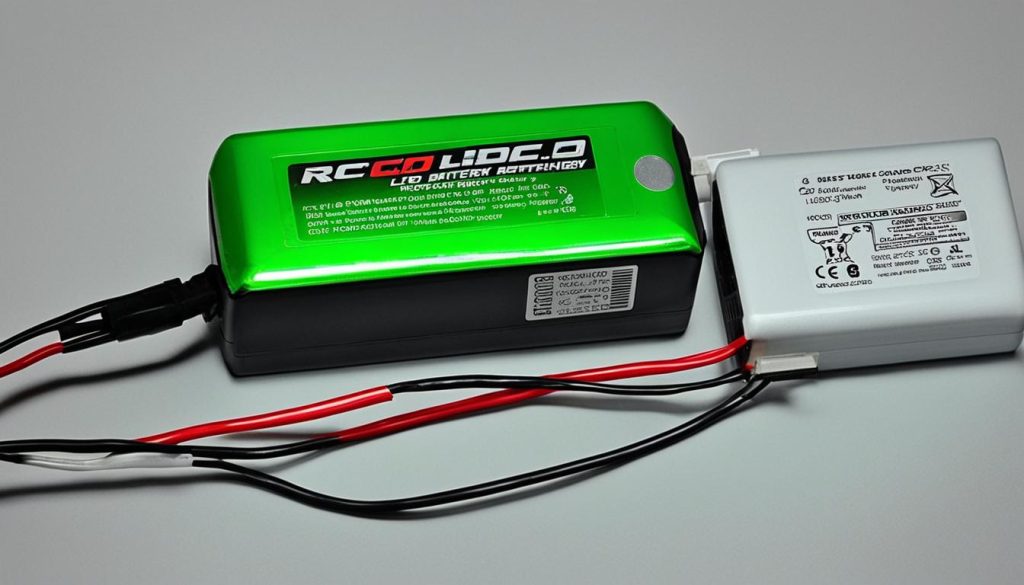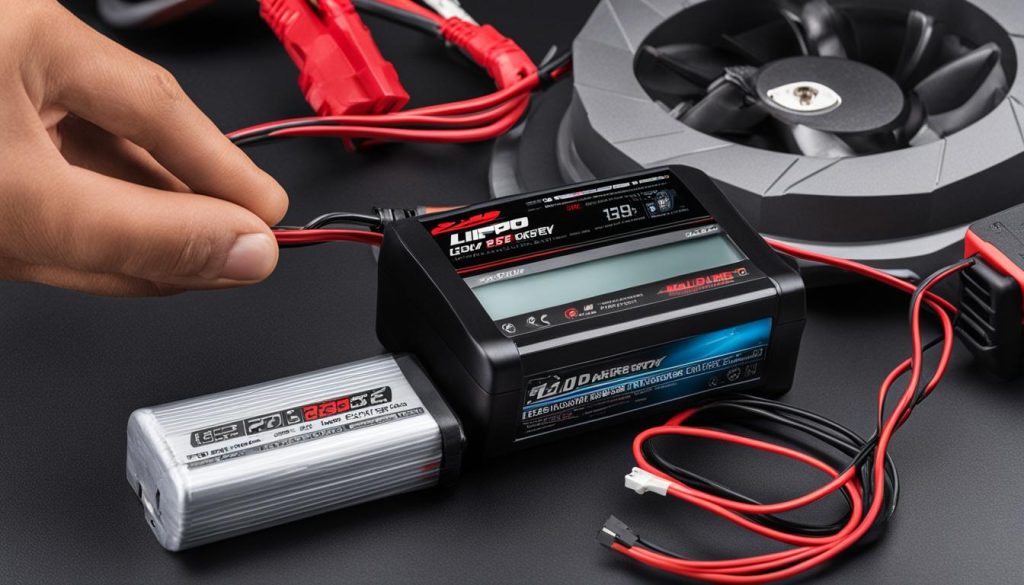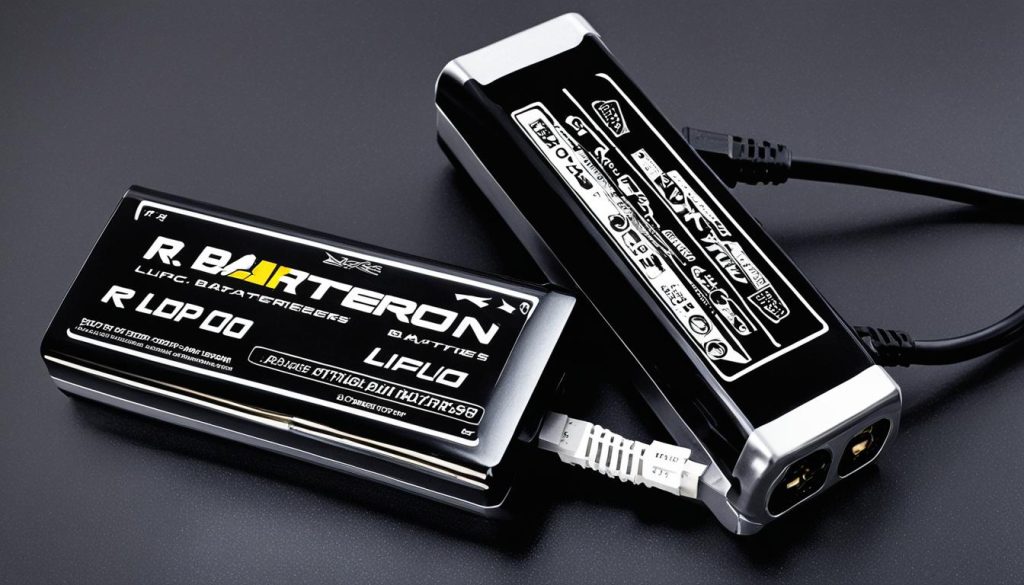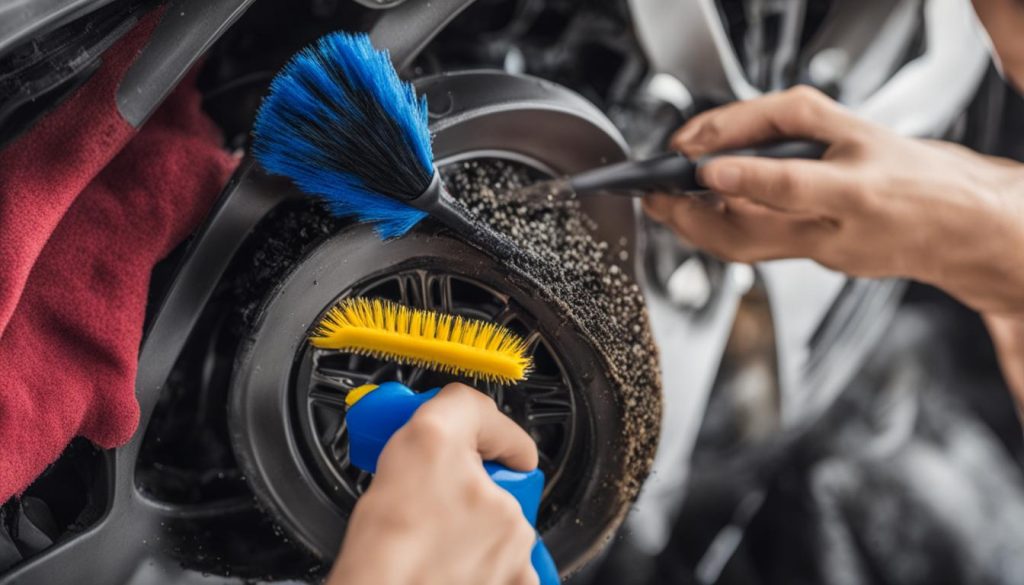In the world of RC, LiPo batteries have gained popularity for their lightweight design, large capacities, and high discharge rates. These batteries are the top choice for RC aircrafts and vehicles, offering high energy storage density and a consistent voltage output. However, it’s essential to understand their lifespan and take proper care to ensure longevity and safety.
Key Takeaways:
- LiPo batteries are popular in the RC world for their lightweight design and high energy storage density.
- Proper care is crucial to maximize the lifespan of LiPo batteries and prevent safety issues.
- Factors such as heat, overcharging, and inadequate balancing can shorten the life of LiPo batteries.
- Understanding LiPo battery basics and proper charging techniques can help extend battery life.
- Follow manufacturer guidelines and perform regular battery maintenance to optimize RC fun.
Understanding LiPo Battery Basics
LiPo batteries, short for Lithium Polymer batteries, have transformed the world of electric RC with their exceptional performance and features. These rechargeable batteries offer a range of advantages that make them a popular choice among RC enthusiasts.
One of the key benefits of LiPo batteries is their lightweight design, which allows for easier maneuverability and improved overall performance. With their large capacities, LiPo batteries can store a significant amount of energy, ensuring longer runtime for your RC aircraft or vehicle.
Another advantage of LiPo batteries is their ability to maintain a consistent voltage output throughout their discharge cycle. This ensures that your RC device receives a steady power supply, enhancing its performance and responsiveness.
LiPo batteries are popular for RC aircrafts due to their high energy storage density.
However, it’s important to note that LiPo batteries do have a few considerations that need to be taken into account. Firstly, they can be more expensive compared to other battery types. Additionally, LiPo batteries have a limited lifespan when used in high current demand applications, such as RC racing or aggressive flying.
To maximize the life of your LiPo battery, proper care and understanding are crucial. Following recommended RC LiPo battery care practices, such as avoiding over-discharging and overcharging, can help prolong the lifespan of your battery.
In summary, LiPo batteries offer RC enthusiasts a lightweight, high-capacity, and consistent voltage power source. While they require proper care and have some limitations, understanding the basics of LiPo batteries will help you make the most of their advantages and extend their lifespan.
| Advantages of LiPo Batteries | Considerations for LiPo Batteries |
|---|---|
|
|
How Are LiPo Batteries Made?
LiPo batteries, short for Lithium Polymer batteries, are manufactured using a unique construction method that allows for flexible and efficient energy storage. Let’s take a closer look at the process and structure of LiPo batteries.
LiPo batteries are commonly packaged in flexible plastic pouch cells, which offer several advantages over traditional cylindrical battery designs. Unlike cylindrical cells, pouch cells can be stacked without wasted air spaces, maximizing the battery’s energy density.
The cell structure of a LiPo battery consists of thin layers of lithium carbon coated aluminum and copper electrodes. These electrodes are laminated in an alternating pattern on a separator film, creating a folded cell matrix. This folded cell matrix is then placed in a soft plastic pouch.
The pouch is filled with a greasy or gel-like solvent-based lithium ion-infused organic polymer electrolyte. This electrolyte allows ions to move between the positively and negatively charged electrodes during the battery’s operation.
LiPo batteries can also be manufactured with hard casings for added protection, especially in ground-based RC vehicles where durability is crucial.
There are different types of LiPo batteries available, each varying in terms of voltage and capacity. These variations allow users to choose the battery that best suits their specific needs in terms of power output and runtime.
Now that we understand how LiPo batteries are made, let’s explore how to choose the right battery for maximum runtime in the next section.
Choosing the Right Battery for Maximum Runtime
In order to maximize your RC vehicle’s runtime, it’s essential to carefully consider the RC LiPo battery specifications, including voltage and capacity. The voltage of the battery directly impacts the top speed of your vehicle, while the capacity determines how long it can run before needing to be recharged.
While it may seem logical to choose a battery with the highest capacity for longer runtime, this isn’t always the best approach. You also need to take into account the Charge: Run Ratio (CRR) to find the optimal balance between charge time and runtime. The CRR is calculated by dividing the charge time by the runtime, and a lower CRR indicates more running time.
It’s important to note that gearing ratios also play a role in your battery’s drainage. Higher gears put less strain on the battery, resulting in longer runtime. However, this may come at the expense of top speed. Experimenting with different gear ratios can help you find the perfect balance between speed and runtime for your RC vehicle.
Voltage and Capacity: Impact on Runtime
The voltage of your RC LiPo battery directly affects the top speed of your vehicle. Higher voltage batteries provide increased power to the motor, resulting in faster acceleration and higher top speeds. If you’re looking for high-speed performance, choosing a battery with a higher voltage rating is crucial.
On the other hand, the capacity of the battery determines how long it can provide power to the motor before needing to be recharged. Batteries with higher capacities have larger energy reserves, allowing for longer runtime. If you prioritize long runtimes over speed, opting for a battery with a higher capacity is the way to go.
It’s important to find the right balance between voltage and capacity for your specific needs. Consider the type of RC vehicle you’re using, the terrain you’ll be driving on, and the intended purpose of your vehicle. Finding the optimal combination of voltage and capacity will help you achieve the desired balance between speed and runtime.
Charge: Run Ratio (CRR)
The Charge: Run Ratio (CRR) is a valuable measure that helps determine the optimal balance between charge time and runtime. To calculate the CRR, divide the charge time by the runtime. A lower CRR indicates more running time, while a higher CRR signifies longer charging times relative to usage.
When selecting an RC LiPo battery, taking the CRR into account is crucial. While it may be tempting to choose a battery with the highest capacity, a high CRR could mean extended charging times that can limit your overall enjoyment. By finding a battery with an optimal CRR, you can strike a balance between runtime and the charging duration.
It’s important to consider your charging setup as well. A charger that can accommodate higher charging currents will allow you to charge higher capacity batteries faster, reducing the CRR. Additionally, if you have the option to charge multiple batteries simultaneously, you can maximize your runtime by having extra batteries ready to go when one runs out of power.
| Battery | Voltage (V) | Capacity (mAh) | Runtime (Minutes) | Charge Time (Minutes) | CRR |
|---|---|---|---|---|---|
| Battery A | 11.1 | 3000 | 20 | 60 | 3:1 |
| Battery B | 14.8 | 4000 | 25 | 80 | 3.2:1 |
| Battery C | 22.2 | 5000 | 30 | 120 | 4:1 |
Gearing Ratios: Considerations for Battery Drain
While the voltage and capacity of your RC LiPo battery directly impact runtime, it’s also important to consider the gearing ratios of your vehicle. Gearing ratios determine how much strain is placed on your battery during operation.
Higher gear ratios allow the motor to operate at a lower speed while still achieving the desired vehicle speed. This reduced strain on the motor results in lower power consumption, which can extend the runtime of your RC vehicle. However, it’s worth noting that higher gearing ratios may affect top speed, as the vehicle won’t be able to reach its maximum potential.
It’s recommended to experiment with different gearing ratios to find the right balance between speed and runtime for your specific RC vehicle. Consider the terrain and driving conditions in which you’ll primarily operate the vehicle. Adjusting the gear ratio can have a significant impact on how quickly your battery drains, allowing you to maximize your runtime and overall enjoyment.
Understanding Charging LiPo Batteries
Charging RC LiPo batteries is a critical process that requires specialized chargers designed for lithium chemistry batteries. To ensure the longevity of your batteries, it is essential to understand the LiPo charging process and adhere to specific guidelines.
When charging LiPo batteries, it is crucial to consider the maximum charge voltage. Each LiPo cell should be charged to a maximum voltage of 4.20 volts per cell. Charging beyond this voltage can significantly decrease the lifespan of your batteries.
To charge LiPo batteries correctly, it is vital to select the appropriate voltage or cell count on your charger. This ensures that each cell receives the correct amount of charge, preventing overcharging or undercharging. Incorrect cell count selection can lead to imbalanced cells and potential safety hazards.
The maximum safe charging current for LiPo batteries depends on their capacity. It is generally recommended to charge LiPo batteries at a rate of 1C (one times the battery capacity). For example, if you have a 2200mAh (2.2Ah) LiPo battery, the recommended charging current would be 2.2A.
Now, let’s take a closer look at the LiPo charging process in a table format:
| Charging Process | Description |
|---|---|
| Step 1: Select the correct voltage or cell count | Determine the number of cells in your LiPo battery pack and set the charger to the corresponding voltage or cell count. |
| Step 2: Connect the LiPo battery to the charger | Use the appropriate charging cable or adapter to connect the LiPo battery to the charger. Make sure the connections are secure and correctly polarized. |
| Step 3: Set the charging current | Adjust the charger settings to the desired charging current. It is recommended to charge LiPo batteries at a 1C rate. |
| Step 4: Start the charging process | Initiate the charging process on the charger. Monitor the charging progress and ensure that the voltage per cell does not exceed 4.20 volts. |
| Step 5: Balanced charging (if applicable) | If you have a LiPo battery pack with multiple cells, ensure that the charger balances the charge between each cell to maintain cell voltage equality. |
| Step 6: Monitoring and safety precautions | Regularly monitor the charging process and be prepared to disconnect the LiPo battery if any signs of swelling, overheating, or other abnormalities are observed. Always follow safety guidelines and keep a fireproof charging bag or container nearby. |
It is essential to follow these charging procedures to ensure the longevity and safe operation of your LiPo batteries. By selecting the correct voltage or cell count, adhering to the maximum charge voltage, and using the appropriate charging current, you can maximize the lifespan of your batteries and enjoy extended RC fun.

Balancing LiPo Batteries for Optimal Performance
Balancing LiPo batteries is crucial for achieving optimal performance and ensuring safety. When it comes to LiPo batteries, balance charging is a vital process that involves charging each individual cell to the same voltage. This technique helps prevent overcharging or undercharging of specific cells, which can lead to battery damage or even fire hazards. To maintain the longevity of your LiPo battery, it’s essential to understand the importance of balance charging and use the right techniques and equipment.
When LiPo batteries have two or more cells connected in series, balancing becomes necessary. In these cases, each individual cell may discharge or charge at a slightly different rate, causing voltage imbalances. By using an appropriate balance charger, you can ensure that each cell receives the required voltage to maintain equilibrium.
Balance charging not only prolongs the life of your LiPo battery but also enhances its overall performance. When all cells are charged to the same voltage, the battery can deliver consistent power and maintain its efficiency throughout its use. This is particularly crucial for high-performance RC applications where a stable power supply is essential for optimal performance.
Using a balance charger simplifies the process of balance charging LiPo batteries. These chargers are designed to monitor and adjust the voltage of each cell individually, ensuring an equal charge across the battery. By investing in a quality balance charger, you can have peace of mind knowing that your LiPo battery is being charged safely and efficiently.
Remember, safety should always be the top priority when handling LiPo batteries. Overcharging or undercharging can have serious consequences, so it’s important to follow the manufacturer’s guidelines and use the appropriate charging equipment. Take the time to educate yourself on proper balance charging techniques, and always stay vigilant when charging LiPo batteries.
Benefits of Balancing LiPo Batteries:
- Prevents overcharging or undercharging of individual cells
- Enhances overall battery performance
- Ensures consistent power delivery
- Prolongs LiPo battery lifespan
Tips for Balance Charging LiPo Batteries:
- Use a balance charger specifically designed for LiPo batteries.
- Set the correct number of cells or voltage when initiating the charge.
- Ensure all the cells are properly connected and secure before charging.
- Monitor the charging process and check the voltage of each cell regularly.
- Avoid interrupting the charging process before it completes.
- Store LiPo batteries at the recommended storage voltage to maintain balance.
- Inspect LiPo batteries for any signs of damage before and after charging.
Common Questions About Balancing LiPo Batteries:
Q: Do I need to balance charge LiPo batteries every time?
A: It is recommended to balance charge LiPo batteries regularly, especially if they are used frequently. This helps maintain voltage balance, ensuring optimal performance.
Q: Can I use a regular charger for LiPo batteries without balance charging?
A: While it is possible to charge LiPo batteries using a regular charger, balance charging is highly recommended to prevent cell imbalances and ensure safe and efficient charging.
| Pros of Balance Charging | Cons of Not Balance Charging |
|---|---|
| Enhanced performance | Risk of overcharging or undercharging |
| Prolonged battery lifespan | Potential cell imbalances |
| Safe and efficient charging | Inconsistent power delivery |
Maintaining LiPo Battery Health
Proper maintenance is crucial for maximizing the lifespan of LiPo batteries. Several factors can impact the life of your LiPo battery, including:
- Heat
- Leaving the LiPo battery fully charged for an extended time
- Over-discharging
- Overcharging
- Inadequate balancing
- Improper storage voltage
- Physical damage
High temperatures can accelerate chemical reactions within the battery and increase internal resistance, leading to shorter battery life. It’s important to avoid subjecting LiPo batteries to extreme temperatures and store them in a cool, dry place.
Leaving a LiPo battery fully charged for an extended period can cause stress and degrade the battery’s performance over time. It’s recommended to discharge the battery to a safe storage voltage when not in use.
Over-discharging a LiPo battery can damage its cells and reduce its overall capacity. It’s crucial to monitor the battery voltage during use and stop using it when the voltage reaches the recommended cutoff.
Overcharging a LiPo battery can cause it to swell, leak, or even catch fire. Always use a proper LiPo charger and follow the manufacturer’s recommendations for voltage and current settings.
Inadequate balancing during charging can lead to uneven cell voltages, which can negatively impact battery performance and safety. Use a balance charger that ensures each cell in the LiPo battery is charged to the same voltage.
Improper storage voltage can also affect the lifespan of LiPo batteries. Storing them at the recommended storage voltage helps maintain their health and longevity.
Regularly inspecting and maintaining the physical integrity of LiPo batteries is essential for their longevity. Check for any signs of damage, such as swelling, punctures, or leaks, and replace damaged batteries immediately.
By following proper LiPo battery maintenance practices, you can significantly extend their lifespan and ensure optimal performance for your RC devices.
Factors Impacting LiPo Battery Life
| Factors | Impact |
|---|---|
| Heat | Increases internal resistance and accelerates chemical reactions |
| Leaving fully charged | Stress on battery and degradation over time |
| Over-discharging | Cell damage and reduced capacity |
| Overcharging | Swell, leak, or fire hazard |
| Inadequate balancing | Uneven cell voltages and reduced performance |
| Improper storage voltage | Negative impact on battery health |
| Physical damage | Compromises battery integrity |
“Proper maintenance is crucial for maximizing the lifespan of LiPo batteries.”
Factors Impacting LiPo Battery Lifespan
Several factors can significantly impact the lifespan of LiPo batteries in your RC devices. It’s crucial to understand and consider these factors to maximize the longevity of your batteries and get the most out of your RC experience.
Heat
Heat is one of the main factors that can shorten the lifespan of LiPo batteries. When exposed to high temperatures, the internal resistance of the battery increases, accelerating chemical reactions within the battery’s cells. This leads to a quicker degradation of the battery’s performance and overall capacity. It is important to avoid exposing LiPo batteries to extreme heat to ensure their longevity.
Depth of Discharge
The depth of discharge refers to how much you drain the battery’s capacity during each use. Deeper discharges can have a negative impact on the lifespan of LiPo batteries. It is advised to avoid fully discharging your LiPo batteries whenever possible, as this can cause irreversible damage and reduce their overall lifespan. Instead, aim for partial discharges to minimize the strain on the battery.
Charging Cycles
The number of charging cycles a LiPo battery goes through can also affect its lifespan. Each time you charge and discharge the battery completely, it counts as one cycle. LiPo batteries have a limited number of cycles before their capacity starts to degrade. It is essential to follow the manufacturer’s guidelines for charging and discharging cycles to prolong the lifespan of your LiPo batteries.
“Proper care and understanding of the factors impacting LiPo battery lifespan can help you enjoy longer-lasting batteries for your RC adventures.”
By being mindful of these factors and implementing proper battery care practices, you can extend the lifespan of your LiPo batteries, saving you money in the long run and ensuring optimal performance for your RC devices.
Tips for Extending LiPo Battery Life
Proper care and maintenance are key to extending the life of your LiPo batteries. By following these tips and best practices, you can enhance their lifespan and optimize their performance.
Avoid High Discharge Rates
High discharge rates put a strain on LiPo batteries and can decrease their lifespan. To prolong battery life, avoid pushing them to their maximum discharge rate. Opt for lower discharge rates to reduce stress on the cells.
Charge at a Slow and Controlled Rate
Rapid charging can generate excessive heat and damage the battery. It’s important to charge LiPo batteries at a slow and controlled rate. This allows for a more efficient transfer of energy and helps prevent overheating.
Properly Balance the Cells
Balancing the cells in a LiPo battery is critical for maintaining their performance and extending their lifespan. Use a balance charger that ensures each cell is charged to the same voltage. Balanced cells promote better overall battery health and longevity.
Store at the Optimal Voltage and Temperature
Proper storage is essential for preserving LiPo batteries. Store them at the optimal storage voltage, which is typically around 3.8-3.85 volts per cell. Avoid storing them fully charged or fully discharged for extended periods. Additionally, maintain a moderate temperature range of 20-25°C (68-77°F) to prevent damage.
Protect from Physical Damage
LiPo batteries are susceptible to physical damage, which can impact their lifespan. Protect your batteries by storing them in a sturdy LiPo bag or container when not in use. Avoid dropping or subjecting them to excessive force or pressure.
By implementing these LiPo battery maintenance tips and practices, you can increase their longevity and ensure a longer and more enjoyable RC experience.

Understanding the Relationship Between Battery Runtime and Charge Time
The Charge: Run Ratio (CRR) is a crucial measure in determining the relationship between battery runtime and charge time. It provides valuable insights into the estimated charge time relative to the estimated runtime, giving you a clear understanding of how these factors influence each other.
A lower CRR indicates longer running time, as it signifies that the battery’s runtime is significantly longer compared to the charging time. On the other hand, a higher CRR indicates a shorter running time, suggesting that the battery’s charge time is relatively longer compared to the runtime. Therefore, it is essential to aim for a lower CRR to maximize the enjoyment of your RC experience.
Several factors can influence the CRR, including battery capacity and charging speed. Battery capacity refers to the amount of charge a battery can store, while charging speed refers to the rate at which the battery can receive and store that charge. By selecting a battery with a larger capacity, you can increase the runtime, allowing for longer periods of RC fun. Similarly, choosing a charger with a faster charging speed reduces the time required to recharge the battery, ensuring minimal downtime between sessions.
However, it is important to strike the right balance between battery capacity and charging speed. Opting for a battery with an excessively high capacity may lead to longer charge times, diminishing the overall efficiency of the setup. Additionally, utilizing a charger with an excessive charging speed may cause unnecessary strain on the battery, potentially affecting its longevity.
To achieve the desired runtime while considering the limitations and performance of both the charger and the battery, it is essential to select the appropriate battery capacity and charge rate. Finding the optimal combination will depend on your specific RC needs and preferences.
Example:
Let’s consider an example to better understand the relationship between battery runtime and charge time. Assume you have a LiPo battery with a capacity of 5000mAh and a charger with a maximum charging speed of 5A (ampere).
Using these values, we can calculate the estimated charge time and runtime, allowing us to determine the CRR.
| Battery Capacity (mAh) | Charging Speed (A) | Estimated Charge Time (hours) | Estimated Runtime (hours) | Charge: Run Ratio (CRR) |
|---|---|---|---|---|
| 5000 | 5 | 1 | 3 | 0.33 |
In this example, the estimated charge time is one hour, while the estimated runtime is three hours. The resulting CRR is 0.33, indicating that for every hour of charging, you can enjoy three hours of RC fun.
By analyzing the CRR, you can make informed decisions when selecting batteries and chargers, optimizing your RC experience and ensuring minimal downtime.
Conclusion
RC LiPo battery longevity is dependent on proper maintenance and optimal charging practices. To extend the lifespan of your RC LiPo batteries, it is crucial to understand and follow the manufacturer’s guidelines. Factors such as heat, overcharging, inadequate balancing, and physical damage can significantly shorten battery life.
By implementing good battery maintenance practices, such as avoiding extreme temperatures, properly storing batteries at optimal voltage, and regularly inspecting for physical damage, you can maximize the lifespan of your RC LiPo batteries.
Additionally, choosing the right charger and battery combination is essential for optimal performance. Be sure to use a charger specifically designed for LiPo batteries and charge them at the recommended maximum voltage and safe charging current. This will help ensure longevity and safe operation of your batteries.
Remember, prioritizing safety is of utmost importance when handling and charging LiPo batteries. By following these guidelines and practices, you can enjoy extended battery life, maximize your RC fun, and have peace of mind knowing you are taking the necessary steps to maintain the health and performance of your RC LiPo batteries.
FAQ
How long do RC LiPo batteries last?
The lifespan of RC LiPo batteries can vary depending on several factors such as usage, maintenance, and charging practices. On average, a LiPo battery can last between 300 to 500 charge and discharge cycles, but this can be significantly shorter if not properly cared for.
What factors can affect the longevity of RC LiPo batteries?
Several factors can impact the lifespan of RC LiPo batteries. These include heat, overcharging, inadequate balancing, deep discharges, and physical damage. It is important to follow proper maintenance procedures and charging guidelines to maximize battery life.
How can I extend the life of my RC LiPo batteries?
To extend the life of your RC LiPo batteries, you can follow these tips:
– Avoid high discharge rates.
– Charge batteries at a slow and controlled rate.
– Properly balance the cells during charging.
– Store LiPo batteries at the optimal voltage and temperature.
– Protect the batteries from physical damage.
Can I use any charger to charge my RC LiPo batteries?
No, it is important to use a charger specifically designed for lithium chemistry batteries, including LiPo batteries. Using the wrong charger or improper charging procedures can result in damage to the batteries or even safety hazards.
What is the optimal storage voltage for LiPo batteries?
LiPo batteries should be stored at approximately 3.8 volts per cell. Storing them at a higher voltage can lead to degradation and reduced lifespan, while storing them below this voltage can cause the batteries to lose capacity.
How important is balancing LiPo batteries?
Balancing LiPo batteries is crucial for optimal performance and safety. Balance charging ensures that each cell in the battery is charged to the same voltage, preventing overcharging or undercharging of individual cells. This helps maintain battery health and prevents potential damage or safety hazards.
What is the Charge: Run Ratio (CRR) and how does it affect battery runtime?
The Charge: Run Ratio (CRR) is a unit of measure that represents the relationship between estimated charge time and estimated runtime. A lower CRR indicates more running time, while a higher CRR means less running time. It is influenced by factors such as battery capacity and charging speed.
How often should I inspect and maintain my LiPo batteries?
Regularly inspecting and maintaining your LiPo batteries is important for maximizing their lifespan. It is recommended to visually check the batteries for physical damage or swelling before and after each use. Additionally, you should regularly balance charge the batteries and ensure they are stored at the proper voltage and temperature.
Can heat affect the lifespan of LiPo batteries?
Yes, heat is one of the main factors that can shorten LiPo battery life. It increases internal resistance and accelerates chemical reactions within the battery, leading to faster degradation. It is important to avoid exposing LiPo batteries to excessive heat and operate RC vehicles in temperature-controlled environments.
Can overcharging LiPo batteries shorten their lifespan?
Yes, overcharging LiPo batteries can significantly reduce their lifespan. LiPo batteries should be charged to a maximum voltage of 4.20 volts per cell. Charging them beyond this voltage can lead to excessive heat generation and chemical reactions that can damage the battery.
Is it necessary to discharge LiPo batteries completely before recharging them?
No, it is not necessary to discharge LiPo batteries completely before recharging them. In fact, it is recommended to avoid deep discharges as they can shorten battery life. It is best to recharge LiPo batteries before they reach critically low voltage levels.




